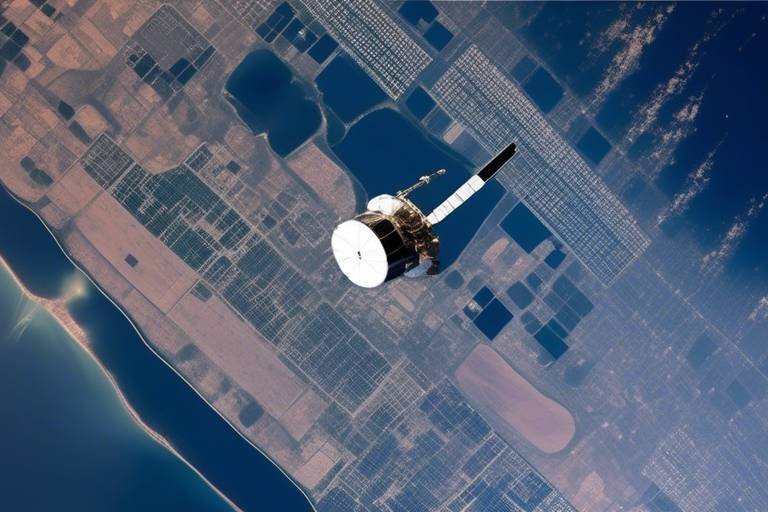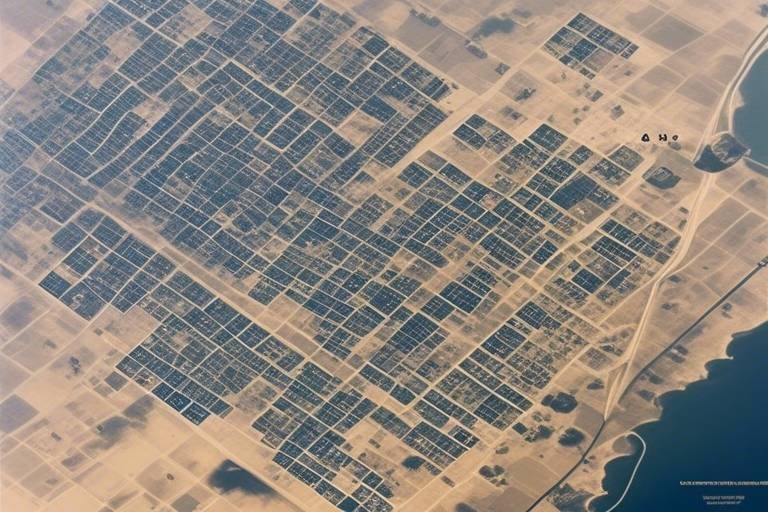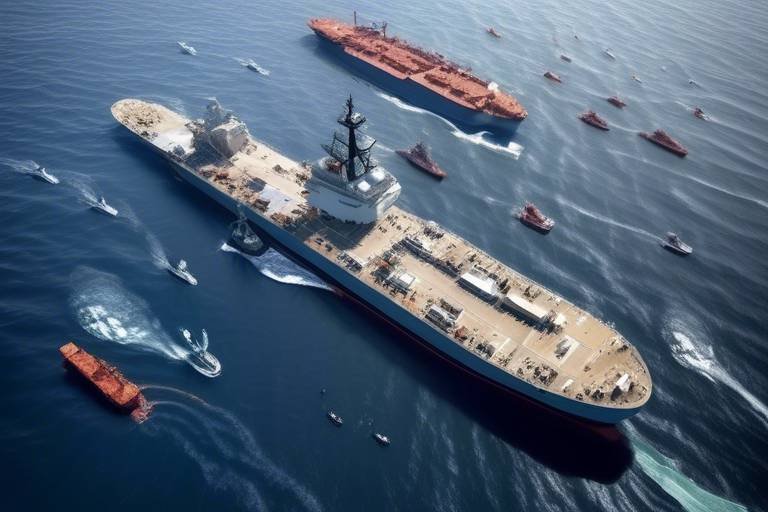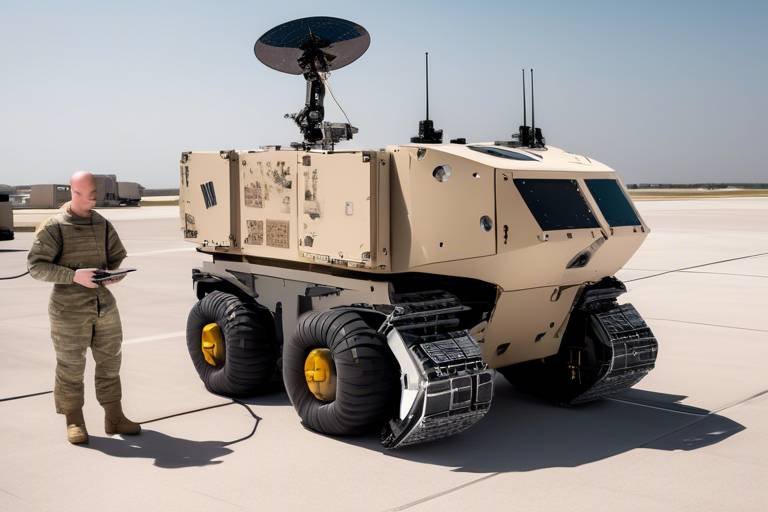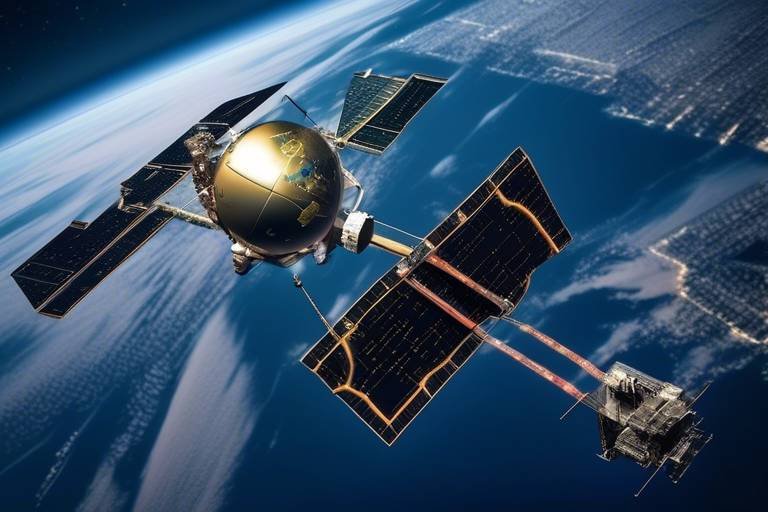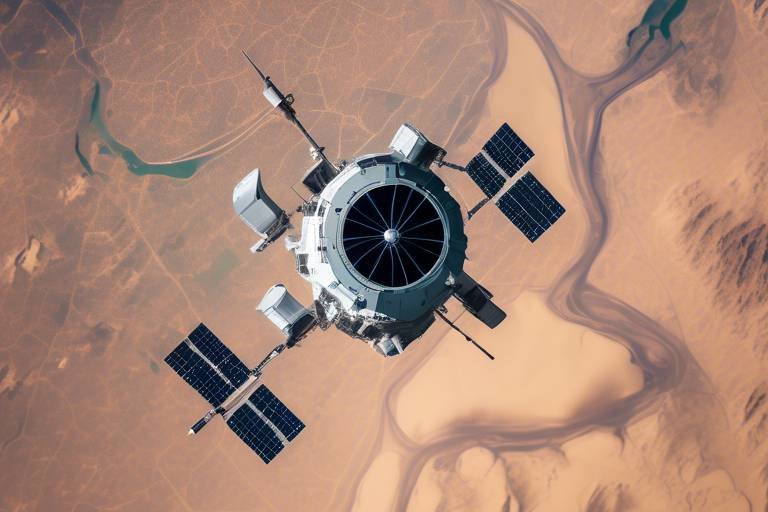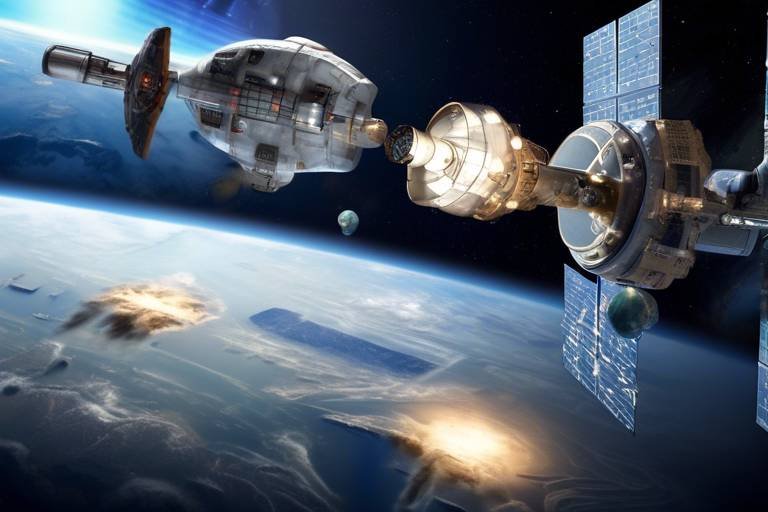The Role of Satellites in Military Planning and Strategy
In the fast-paced world of modern warfare, the importance of satellites cannot be overstated. These technological marvels serve as the backbone of military operations, influencing everything from intelligence gathering to strategic decision-making. Imagine trying to navigate a complex battlefield without the ability to see the enemy's movements or coordinate your forces effectively; it would be like sailing a ship without a compass. Satellites provide that crucial navigational aid, enabling military planners to craft strategies that are both informed and adaptive.
As we delve deeper into this topic, we'll explore how satellites enhance operational efficiency and effectiveness in various military contexts. From surveillance and reconnaissance to communication systems and navigation, the multifaceted roles of satellites are pivotal in shaping the outcomes of military operations. In essence, satellites not only provide a bird's-eye view of the battlefield but also act as a vital communication link, ensuring that the right information reaches the right people at the right time.
Moreover, the integration of Global Positioning Systems (GPS) has revolutionized how military forces engage in operations. Troops can now operate in diverse environments with pinpoint accuracy, which is essential for mission success. But it's not just about precision; it's about having the ability to adapt to changing circumstances on the ground. The intelligence gathered from satellites allows military leaders to make informed decisions, adjust their strategies, and ultimately, achieve their objectives with greater effectiveness.
However, the reliance on satellites also brings its own set of challenges. Vulnerabilities to enemy attacks and limitations in coverage can impact the effectiveness of these systems. As we look towards the future, emerging technologies promise to enhance satellite capabilities, offering new strategic opportunities for armed forces worldwide. The landscape of military planning is evolving, and satellites will continue to play a crucial role in shaping that evolution.
- How do satellites gather intelligence? Satellites collect data through various sensors and imaging technologies that monitor enemy movements and gather essential information.
- What role does GPS play in military operations? GPS technology allows for precise navigation and targeting, enabling military forces to operate effectively and improve mission outcomes.
- What challenges do military satellites face? Satellites can be vulnerable to enemy attacks and may have limitations in coverage, which can affect their operational effectiveness.
- How is satellite technology evolving? Emerging technologies are enhancing satellite capabilities, promising new functionalities and strategic opportunities for military planning.
Satellite Technology Overview
In the realm of military operations, understanding satellite technology is essential for grasping how modern warfare is conducted. Satellites are not just shiny objects orbiting the Earth; they are sophisticated machines equipped with advanced technologies that serve various military purposes. From communication to reconnaissance, the capabilities of these satellites have evolved tremendously over the years, enhancing their role in military strategy and planning.
To break it down, there are several types of satellites, each designed with specific functionalities. These include:
- Communication Satellites: These are crucial for maintaining secure lines of communication between military units, ensuring that commands and intelligence are transmitted without interception.
- Earth Observation Satellites: Equipped with high-resolution cameras, these satellites provide detailed images of the Earth's surface, allowing for extensive surveillance and reconnaissance.
- Navigational Satellites: These are essential for GPS technology, aiding in precise navigation and targeting.
- Weather Satellites: Understanding weather patterns can be critical in military operations; these satellites provide vital data on atmospheric conditions.
The advancements in satellite technology are nothing short of astonishing. Modern satellites are now equipped with AI-driven analytics that can process vast amounts of data in real time, providing actionable intelligence at the speed of light. This capability allows military planners to make quick decisions, adapting their strategies based on the most current information available.
Moreover, the integration of miniaturization and micro-satellite technology has led to the deployment of smaller, more agile satellites that can be launched more economically. These smaller satellites can work in swarms, providing a comprehensive view of the battlefield while reducing the risk of losing a single, larger satellite.
However, with these advancements come challenges. The increasing reliance on satellite technology makes military operations vulnerable to cyberattacks and anti-satellite weaponry. As nations continue to develop capabilities to target satellites, the military must also invest in defensive measures to protect these critical assets.
In conclusion, the landscape of military operations is being reshaped by satellite technology. As we move forward, the ongoing evolution of these technologies will undoubtedly play a pivotal role in shaping military strategy and operational effectiveness.
Intelligence Gathering
In the realm of modern warfare, has become a cornerstone for military operations, and satellites are at the forefront of this critical task. Imagine trying to navigate a maze blindfolded; that’s what military strategists face without accurate intelligence on enemy positions and movements. Satellites provide a bird's-eye view of the battlefield, allowing forces to monitor activities from a distance that would otherwise be impossible.
These high-tech marvels are equipped with various sensors and imaging technologies that can capture detailed information about ground activities. For instance, electro-optical sensors can take high-resolution images, while infrared sensors can detect heat signatures, revealing troop movements even at night. This capability enables military planners to gather actionable intelligence that informs their strategies and decisions, ensuring they are always one step ahead of their adversaries.
Furthermore, satellites can operate in different orbits to enhance their surveillance capabilities.
| Orbit Type | Altitude (km) | Key Advantages |
|---|---|---|
| Low Earth Orbit (LEO) | 160 - 2,000 | High-resolution imaging, real-time data |
| Medium Earth Orbit (MEO) | 2,000 - 35,786 | Balance between coverage and resolution |
| Geostationary Orbit (GEO) | 35,786 | Constant coverage over specific areas |
By leveraging these different orbits, military forces can optimize their surveillance operations, ensuring comprehensive coverage of conflict zones. The data collected from these satellites is not just numbers and images; it translates into intelligence reports that can dictate the success of missions. For example, knowing the location of enemy troops can lead to strategic advantages, allowing for preemptive strikes or the avoidance of ambushes.
Moreover, the integration of artificial intelligence (AI) into satellite imagery analysis has revolutionized the speed and accuracy of intelligence gathering. AI algorithms can sift through vast amounts of data, identifying patterns and anomalies that human analysts might miss. This technological synergy enhances the military's ability to respond swiftly to emerging threats, making intelligence gathering not just about collecting data, but about transforming it into actionable insights.
However, the reliance on satellites for intelligence gathering also poses challenges. Adverse weather conditions can obscure satellite imagery, and advancements in enemy technology can lead to countermeasures designed to jam or deceive satellite signals. This cat-and-mouse game highlights the need for continuous innovation and adaptation in military satellite technology.
In conclusion, the role of satellites in intelligence gathering cannot be overstated. They provide the essential data that shapes military strategies and operations, turning the fog of war into a clearer picture of the battlefield. As technology evolves, so too will the capabilities of these satellites, ensuring that they remain an indispensable tool for military forces around the globe.
- How do satellites collect intelligence? Satellites use various sensors to capture images and data about ground activities, including troop movements and infrastructure.
- What are the different types of satellites used for military intelligence? Military satellites can be categorized into those in Low Earth Orbit (LEO), Medium Earth Orbit (MEO), and Geostationary Orbit (GEO), each serving different purposes.
- Can weather affect satellite intelligence gathering? Yes, adverse weather conditions such as clouds and storms can obscure satellite imagery, impacting the quality of intelligence collected.
Surveillance and Reconnaissance
In the fast-paced world of modern warfare, surveillance and reconnaissance have become indispensable components of military strategy. Satellites, with their advanced technological capabilities, provide a bird's-eye view of conflict zones, enabling military leaders to maintain a pulse on enemy movements and activities. Imagine having a high-tech pair of binoculars that can see not just across the battlefield, but also into the depths of enemy territory—this is what satellites offer.
Utilizing satellites for surveillance allows military forces to collect real-time data, which is crucial for making informed decisions. With the ability to capture high-resolution images and gather signals intelligence, satellites act as the eyes and ears of the military. They can monitor troop concentrations, supply routes, and even detect missile launches. This data is invaluable, as it informs tactical maneuvers and strategic planning, ensuring that military operations are based on accurate and timely information.
One of the most significant advantages of satellite surveillance is its ability to operate in various weather conditions and at all hours of the day. Unlike traditional reconnaissance methods that may be hindered by clouds or darkness, satellites can provide continuous coverage, which is essential during critical operations. This capability not only enhances situational awareness but also minimizes the risk of surprise attacks from adversaries.
Moreover, the integration of drone technology with satellite systems has taken surveillance to a new level. Drones can be deployed to gather additional data in specific areas of interest, while satellites provide a broader overview. This combination creates a comprehensive surveillance network that can adapt to changing battlefield dynamics. For instance, if a satellite detects unusual activity in a remote location, drones can be dispatched for closer inspection, providing detailed insights that can influence immediate tactical decisions.
However, it's essential to recognize that satellite surveillance is not without its challenges. Adversaries are increasingly aware of these capabilities and are developing countermeasures to disrupt satellite operations. The potential for signal jamming and other forms of electronic warfare poses significant risks to satellite effectiveness. Therefore, military planners must continuously evolve their strategies to counter these threats, ensuring that their surveillance capabilities remain robust and reliable.
In conclusion, the role of satellites in surveillance and reconnaissance is pivotal in shaping military operations. They provide critical data that enhances situational awareness, informs strategic planning, and ultimately contributes to mission success. As technology continues to advance, the integration of satellites with other platforms will likely redefine the landscape of military surveillance, making it even more effective and indispensable in the ever-evolving theater of war.
- What are the primary functions of military satellites? Military satellites primarily serve functions in surveillance, reconnaissance, communication, navigation, and intelligence gathering.
- How do satellites enhance real-time monitoring? Satellites can provide continuous data collection and high-resolution imagery, allowing military leaders to monitor situations as they unfold.
- What challenges do military satellites face? Major challenges include vulnerability to enemy attacks, signal jamming, and limitations in coverage due to various factors such as terrain and technology.
- How do drones complement satellite surveillance? Drones can be deployed for targeted reconnaissance in areas of interest, while satellites provide a broader overview, creating a comprehensive surveillance capability.
Communication Systems
In the realm of modern warfare, effective communication can mean the difference between victory and defeat. Military operations often unfold in chaotic environments where every second counts, and this is where satellite communication systems come into play. These systems provide a backbone for military coordination, enabling troops to communicate with one another regardless of their location on the globe. Imagine trying to coordinate a complex operation without being able to communicate in real-time—it's like trying to conduct an orchestra where the musicians can't hear the conductor!
Satellites facilitate a range of communication methods, including voice, data, and video transmissions. This capability is particularly crucial for joint operations, where multiple branches of the military must work together seamlessly. With satellite communication, commanders can relay orders, share intelligence, and receive updates from the field instantaneously, ensuring that everyone is on the same page. The reliability and security of these channels are paramount, especially in hostile environments where traditional communication methods may be compromised.
Moreover, satellite communication systems are designed to be resilient. They can operate in various conditions, from extreme weather to electronic warfare scenarios. The use of encrypted signals enhances security, making it difficult for adversaries to intercept or jam communications. This feature is vital for maintaining operational security, as sensitive information must remain confidential to protect military strategies and troop movements.
Let's take a closer look at how satellite communication systems are structured and the technology behind them:
| Type of Communication | Description | Advantages |
|---|---|---|
| Voice Communication | Real-time audio transmission between units. | Immediate feedback and coordination. |
| Data Communication | Transmission of intelligence reports and mission data. | Fast, secure sharing of critical information. |
| Video Communication | Live video feeds from drones or reconnaissance units. | Enhanced situational awareness for commanders. |
As the military continues to evolve, so do the technologies that support it. The integration of advanced satellite communication systems has transformed how military forces plan and execute operations. Innovations such as high-throughput satellites and multi-band communication systems are enhancing bandwidth and connectivity, allowing for more extensive and reliable communications. This evolution ensures that military leaders can make informed decisions based on real-time data, ultimately improving mission outcomes.
In conclusion, the role of satellite communication systems in military operations cannot be overstated. They provide the essential framework for coordinating complex missions, ensuring that troops remain connected even in the most challenging environments. As technology advances, we can expect these systems to become even more sophisticated, further enhancing the effectiveness and efficiency of military operations worldwide.
- How do satellite communication systems work? Satellite communication systems work by transmitting signals from ground stations to satellites in orbit, which then relay those signals to other ground stations or units, enabling communication across vast distances.
- What are the advantages of using satellites for military communication? The advantages include global coverage, secure and encrypted communication channels, resilience in harsh environments, and the ability to transmit voice, data, and video in real-time.
- Can satellite communication be disrupted? Yes, satellite communication can be vulnerable to jamming or hacking attempts. However, military systems are designed with multiple layers of security to mitigate these risks.
Navigation and Targeting
In the realm of modern warfare, are pivotal components that can determine the success or failure of military operations. With the integration of satellite technology, military forces have gained unprecedented capabilities that enhance their operational effectiveness. Imagine trying to find your way in a vast, unfamiliar city without a map or GPS—this scenario is akin to what military units faced before the advent of satellite navigation. Now, with satellites overhead, they can navigate with pinpoint accuracy, ensuring that every move is calculated and strategic.
Satellites provide essential data that aids in precise navigation. By utilizing Global Positioning System (GPS) technology, military personnel can determine their exact location anywhere on the globe, even in the most challenging terrains. This capability is not just about knowing where you are; it’s about knowing where you need to be and how to get there safely and efficiently. For instance, during a mission, if troops are navigating through dense forests or urban environments, satellite navigation allows them to plot the best route, avoiding obstacles and potential ambushes.
Furthermore, the role of satellites in targeting cannot be overstated. They enable military forces to accurately identify and engage targets with remarkable precision. This is particularly crucial in operations where civilian safety is paramount. By using satellite imagery and data, military planners can assess the battlefield, identify enemy positions, and plan strikes that minimize collateral damage. The combination of real-time data and advanced targeting systems ensures that every operation is executed with the highest level of accuracy.
To illustrate this, consider the following table that highlights the key benefits of satellite navigation and targeting:
| Benefit | Description |
|---|---|
| Precision | Accurate location tracking allows for targeted strikes and reduced collateral damage. |
| Real-Time Updates | Continuous data feed from satellites provides updated situational awareness. |
| Enhanced Coordination | Units can communicate and coordinate movements effectively, improving operational success. |
| Adaptability | Military strategies can be adjusted in real-time based on satellite data. |
Moreover, the integration of satellite technology into navigation and targeting systems has led to the development of advanced munitions that can be guided to their targets with incredible accuracy. This means that a missile launched from a distance can be directed to hit a specific target, much like a guided arrow finding its mark. This level of precision not only enhances mission success rates but also plays a significant role in strategic planning, allowing military leaders to make informed decisions based on the data collected from satellites.
However, it is essential to recognize that while satellite navigation and targeting have transformed military operations, they are not without challenges. Issues such as signal interference, satellite vulnerability to enemy attacks, and reliance on technology can pose risks. Despite these challenges, the advantages far outweigh the drawbacks, making satellite technology an indispensable tool in modern military strategy.
In conclusion, the evolution of navigation and targeting through satellite technology has redefined the landscape of military operations. With the ability to navigate accurately and engage targets precisely, military forces can operate more effectively in complex environments. As technology continues to advance, we can only anticipate even greater enhancements in these critical areas of military planning and execution.
- How do satellites improve military navigation? Satellites provide accurate GPS data that allows military units to determine their exact location and navigate effectively in various terrains.
- What role do satellites play in targeting? Satellites enable precise identification of targets, allowing for accurate strikes and minimizing collateral damage.
- Are there risks associated with satellite navigation and targeting? Yes, challenges such as signal interference and vulnerability to attacks can impact their effectiveness.
- How has technology changed military operations? Advanced satellite technology has significantly improved operational efficiency, situational awareness, and strategic planning.
Global Positioning Systems (GPS)
The integration of into military operations has been nothing short of revolutionary. Imagine being in the middle of a vast battlefield, surrounded by chaos, and yet having the ability to pinpoint your exact location with remarkable accuracy. This is the power that GPS brings to the table. It allows military personnel to navigate through diverse environments—be it dense forests, arid deserts, or urban landscapes—ensuring that they can carry out their missions effectively and efficiently.
GPS technology operates through a constellation of satellites orbiting the Earth, continuously transmitting signals that enable receivers on the ground to determine their precise location. This capability is not just a luxury; it is a necessity in modern warfare where every second counts. For instance, during operations, soldiers can receive real-time updates about their position, the location of friendly units, and even potential threats. This level of situational awareness is crucial for making informed decisions in high-stakes scenarios.
Moreover, GPS plays a vital role in enhancing the accuracy of targeting systems. When it comes to delivering munitions, precision is key. With GPS-guided munitions, military forces can strike targets with pinpoint accuracy, minimizing collateral damage and maximizing operational effectiveness. This technology has transformed the way military planners approach targeting, allowing them to execute missions with greater confidence.
However, the benefits of GPS are not without challenges. While the technology has advanced significantly, it is still vulnerable to various threats. For example, adversaries can employ jamming techniques to disrupt GPS signals, rendering the system less effective. Additionally, reliance on GPS can create a single point of failure; if the system goes down, it could lead to confusion and disarray among troops on the ground. Therefore, military strategists must consider these vulnerabilities and develop contingency plans to mitigate potential risks.
In summary, the integration of GPS technology into military operations has transformed navigation and targeting, offering unprecedented accuracy and situational awareness. As technology continues to evolve, the military's reliance on GPS will likely increase, underscoring the need for robust security measures to protect this critical asset.
- What is GPS? Global Positioning System (GPS) is a satellite-based navigation system that provides location and time information anywhere on Earth.
- How does GPS work in military operations? GPS allows military personnel to determine their precise location, navigate effectively, and enhance the accuracy of targeting systems.
- What are the vulnerabilities of GPS? GPS can be vulnerable to jamming and spoofing, which can disrupt its signals and impact military operations.
- Why is GPS important in modern warfare? GPS provides critical situational awareness and precision targeting, which are essential for successful military operations.
Impact on Strategy Development
The integration of satellite technology into military operations has profoundly transformed the landscape of strategy development. Imagine having an eagle's eye view of the battlefield, where every movement is captured and analyzed in real-time. This capability is not just a luxury; it’s a necessity in modern warfare. Satellites provide a wealth of data that military leaders can leverage to make informed decisions, anticipate enemy actions, and adapt their strategies accordingly.
One of the most significant impacts of satellite data on strategy development is the enhancement of situational awareness. With satellites continuously monitoring conflict zones, commanders gain a comprehensive understanding of the battlefield dynamics. This information allows them to identify patterns, assess threats, and allocate resources more effectively. For instance, if satellites detect a buildup of enemy forces in a particular area, military planners can swiftly adjust their strategies to counter this threat, ensuring that they remain one step ahead.
Moreover, the ability to gather and analyze satellite imagery has revolutionized intelligence operations. High-resolution images provide critical insights into enemy infrastructure, troop movements, and logistical routes. By understanding these elements, military leaders can devise strategies that exploit weaknesses in the enemy's plans. For example, if a satellite reveals that an enemy supply line is vulnerable, forces can be mobilized to disrupt it, crippling the opponent’s ability to sustain operations.
Furthermore, the use of satellite data fosters a culture of adaptability within military organizations. In today’s fast-paced conflict environments, the ability to pivot and respond to changing circumstances is crucial. With real-time data at their fingertips, commanders can evaluate the effectiveness of their strategies and make necessary adjustments on the fly. This agility can mean the difference between victory and defeat.
However, it’s important to recognize that relying on satellite data also presents challenges. The vast amount of information available can be overwhelming, and military leaders must be adept at filtering out noise to focus on what truly matters. Additionally, the potential for data manipulation or misinformation poses risks that can lead to flawed decision-making. Therefore, developing robust analytical frameworks and training personnel to interpret satellite data accurately is essential for maximizing its strategic value.
In conclusion, the impact of satellites on strategy development in military operations cannot be overstated. They provide unparalleled insights that enhance situational awareness, inform tactical decisions, and foster adaptability. As technology continues to evolve, the role of satellites in shaping military strategy will only become more pronounced, making them an indispensable asset in the arsenal of modern armed forces.
- How do satellites improve military communication?
Satellites provide secure and reliable channels for data transmission, allowing for effective coordination among military units. - What types of data can satellites collect?
Satellites can gather various types of data, including imagery, signals intelligence, and environmental monitoring, which are crucial for informed decision-making. - Are satellites vulnerable to enemy attacks?
Yes, satellites can be targeted by adversaries, which poses a risk to their effectiveness in military operations. - What future trends are expected in military satellite technology?
Emerging technologies promise enhanced functionalities, such as improved imaging capabilities and faster data processing, shaping the future of military planning.
Challenges and Limitations
While satellites have undeniably transformed military operations, their use is not without significant . One of the primary concerns is their vulnerability to enemy attacks. In an age where electronic warfare is becoming increasingly sophisticated, adversaries are developing methods to jam, spoof, or even destroy satellite communications. This raises critical questions: What happens to military operations when satellites are compromised? Can alternative systems be relied upon in such scenarios?
Another limitation lies in the coverage gaps that can occur due to the orbits of satellites. Not all regions of the Earth can be monitored continuously, particularly in remote or polar areas. This can lead to blind spots in intelligence gathering, leaving military leaders in the dark about enemy movements in crucial areas. For example, during a conflict, if a satellite is not in the right position at the right time, it might miss significant developments, which could alter the course of operations.
Moreover, the sheer amount of data collected by satellites can be overwhelming. Military analysts must sift through vast quantities of information to identify actionable intelligence. This process can be time-consuming and may lead to information overload, where critical insights are lost amid the noise. As a solution, advanced data analytics and artificial intelligence are being integrated to help filter and interpret satellite data more effectively.
Furthermore, the high costs associated with launching and maintaining satellites present a significant barrier. Developing, deploying, and operating these complex systems requires substantial financial investment, often diverting funds from other critical areas of military spending. The question arises: is the investment in satellite technology justifiable when budgets are tight and other pressing needs exist?
Lastly, there's the issue of legal and ethical considerations. The use of satellites for surveillance can raise privacy concerns, both domestically and internationally. As military operations increasingly rely on satellite data, the potential for misuse or overreach grows. This necessitates a careful balance between operational effectiveness and the respect for privacy rights. How can military forces ensure they are using this technology responsibly while still achieving their strategic objectives?
In conclusion, while satellites are integral to modern military planning and strategy, they are not a panacea. Understanding these challenges and limitations is crucial for military leaders as they navigate the complexities of modern warfare. The future of military operations will depend not only on advancements in satellite technology but also on addressing these inherent vulnerabilities and ethical dilemmas.
- What are the main vulnerabilities of military satellites? Military satellites face threats from enemy attacks, including jamming and spoofing, which can compromise their effectiveness.
- How do coverage gaps affect military operations? Coverage gaps can create blind spots in intelligence gathering, leaving military leaders uninformed about enemy movements in critical areas.
- What is information overload in satellite data analysis? Information overload occurs when analysts are overwhelmed by the vast amounts of data collected, making it challenging to identify actionable intelligence.
- Are military satellites expensive to maintain? Yes, the costs associated with launching and maintaining satellites require substantial financial investment, which can impact other military budget areas.
- What are the legal concerns related to satellite surveillance? Satellite surveillance can raise privacy concerns, necessitating a balance between operational needs and respect for privacy rights.
Future Trends in Military Satellites
As we gaze into the crystal ball of military technology, it's clear that the future of military satellites is not just bright; it’s practically dazzling! With rapid advancements in technology, the landscape of satellite capabilities is evolving at an unprecedented pace. Imagine a world where satellites are not merely observers but active participants in military strategy. This shift is driven by several key trends that promise to reshape how armed forces operate on a global scale.
One of the most exciting developments is the rise of small satellites, or smallsats. These compact yet powerful devices are revolutionizing the way military forces gather intelligence. Unlike traditional satellites, which can be large and expensive, smallsats are cost-effective and can be deployed in swarms. This allows for greater coverage and more frequent updates on enemy movements. Picture a fleet of tiny drones buzzing above the battlefield, each relaying crucial information back to commanders in real time. The agility and flexibility offered by smallsats can significantly enhance situational awareness and operational effectiveness.
Moreover, the integration of artificial intelligence (AI) into satellite technology is poised to be a game-changer. AI can analyze vast amounts of data collected from satellites, identifying patterns and anomalies that human analysts might miss. This capability allows military leaders to make informed decisions faster than ever before. Imagine AI algorithms processing satellite imagery to detect troop buildups or unusual movements, alerting commanders within moments. This level of responsiveness could be the difference between success and failure in critical missions.
Additionally, the future of military satellites will likely see an increase in inter-satellite communication. Instead of relying solely on ground stations, satellites will communicate directly with each other, forming a network that can relay information instantaneously. This mesh network approach enhances resilience, ensuring that even if one satellite is compromised, the others can continue to function and share data. It’s like having a group of friends who always have each other’s backs, no matter the circumstances.
Furthermore, the concept of hyperspectral imaging is gaining traction. This advanced technology allows satellites to capture data across a wide spectrum of wavelengths, providing detailed insights into the environment and enemy capabilities. Hyperspectral imaging can identify materials, monitor changes in landscapes, and even assess the health of crops, which can be crucial in understanding the broader operational context. Imagine being able to see through camouflage or detect hidden installations simply by analyzing the light reflected off surfaces. This capability will undoubtedly enhance the military's strategic edge.
As we explore these trends, it's important to acknowledge the role of international collaboration in satellite technology. Countries around the world are recognizing the need for shared intelligence and joint operations. Collaborative efforts can lead to the development of more sophisticated satellite systems that benefit multiple nations. Think of it as a global alliance where nations pool their resources and expertise, creating a more formidable collective defense strategy.
In conclusion, the future of military satellites is not only about improved technology but also about how these innovations can be strategically leveraged. As small satellites, AI, inter-satellite communication, hyperspectral imaging, and international collaboration come together, we can expect a new era of military operations that is more efficient, effective, and responsive to the ever-changing dynamics of warfare. The sky is truly the limit!
- What are small satellites, and how do they benefit military operations? Small satellites are compact, cost-effective devices that can be deployed in swarms to gather intelligence, providing greater coverage and more frequent updates on enemy movements.
- How does artificial intelligence enhance satellite capabilities? AI analyzes large data sets from satellites, identifying patterns and anomalies to help military leaders make informed decisions quickly.
- What is hyperspectral imaging? Hyperspectral imaging captures data across various wavelengths, allowing for detailed insights into the environment, enemy capabilities, and even detecting hidden installations.
- Why is international collaboration important in satellite technology? Collaborative efforts lead to the development of more sophisticated satellite systems that benefit multiple nations, enhancing collective defense strategies.
Frequently Asked Questions
- What role do satellites play in military operations?
Satellites are crucial in military operations as they provide essential capabilities in intelligence gathering, surveillance, and communication. They help military forces monitor enemy movements, collect data, and ensure secure communication channels, which are vital for successful operations.
- How do satellites assist in intelligence gathering?
Satellites collect a vast amount of intelligence data that allows military leaders to gain insights into enemy activities. This data can include imagery, signals intelligence, and other information that is critical for strategic planning and decision-making.
- What is the significance of surveillance and reconnaissance via satellites?
Utilizing satellites for surveillance and reconnaissance enables real-time monitoring of conflict zones. This capability ensures that military leaders have the most current situational awareness, allowing them to adapt their strategies effectively based on the evolving battlefield conditions.
- How do satellites enhance military communication?
Satellites improve military communication by providing secure and reliable channels for data transmission. This is essential for coordination among different military units, ensuring that they can operate seamlessly and respond quickly to changing situations.
- What role does GPS play in military operations?
GPS technology is a game changer in military operations, facilitating accurate navigation and targeting. It allows troops to pinpoint their locations and guide munitions precisely, thus enhancing the effectiveness of military actions.
- How do satellites influence military strategy development?
Satellite data significantly influences military strategy development. By providing accurate and timely information, military leaders can make informed decisions and adapt their plans to the dynamic nature of the battlefield, ultimately leading to more effective operations.
- What are some challenges faced by military satellites?
Despite their advantages, military satellites face challenges such as vulnerability to enemy attacks and limitations in coverage. These factors can impact their effectiveness and require military planners to consider alternative strategies.
- What are future trends in military satellite technology?
The future of military satellites is promising, with emerging technologies and innovations shaping their capabilities. Advancements are expected to enhance functionalities and create new strategic opportunities for armed forces, ensuring they remain effective in modern warfare.


